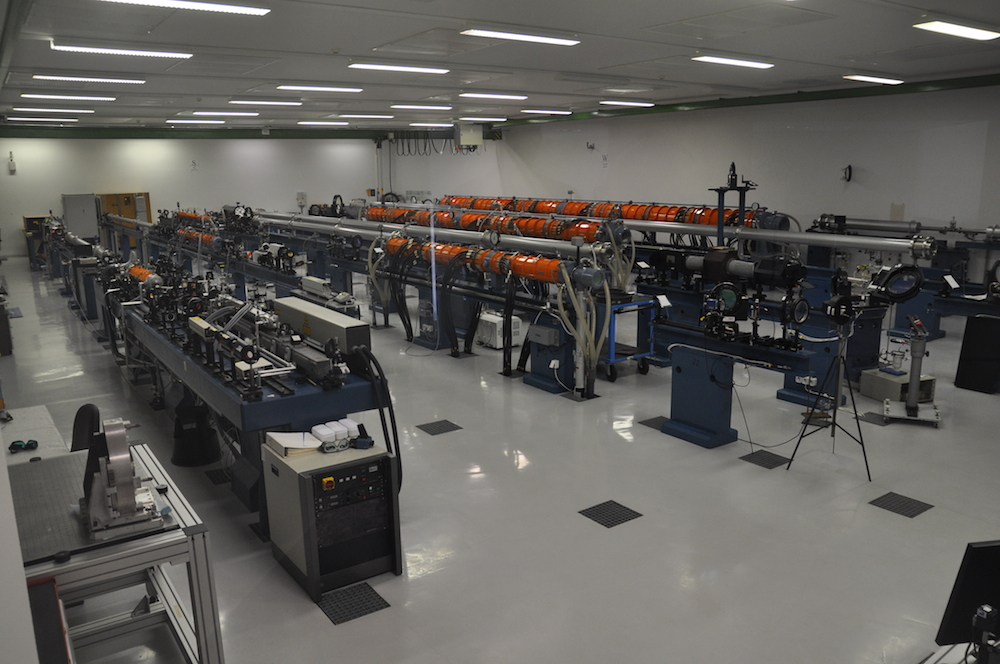Laser-Zapping Experiment Simulates Beginnings of Life on Earth

The origin of life on Earth about 4 billion years ago remains one of the biggest unsolved mysteries of science, but a new study is shedding light on the matter.
To recreate the conditions thought to exist on Earth when life began, scientists used a giant laser to ignite chemical reactions that converted a substance found on the early Earth into the molecular building blocks of DNA, the blueprint for life.
The findings not only offer support for theories of how life first formed, but could also aid in the search for signs of life elsewhere in the universe, the researchers said. [7 Theories on the Origin of Life]
The beginning of life coincides with a hypothetical event that occurred 4 billion to 3.85 billion years ago, known as the Late Heavy Bombardment, in which asteroids pummeled Earth and the solar system's other inner planets. These impacts may have provided the energy to jumpstart the chemistry of life, scientists say.
In 1952, the chemists Stanley Miller and Harold Urey conducted a famous experiment at the University of Chicago in which they simulated the conditions thought to be present on early Earth. This experiment was intended to show how the basic materials for life could be produced from nonliving matter.
Recent studies suggest that asteroid impacts may break down formamide — a molecule thought to be present in early Earth's atmosphere — into genetic building blocks of DNA and its cousin RNA, called nucleobases.
In their new study, chemist Svatopluk Civiš, of the Academy of Sciences of the Czech Republic, and his colleagues used a high-powered laser to break down ionized formamide gas, or plasma, to mimic an asteroid strike on early Earth.
Sign up for the Live Science daily newsletter now
Get the world’s most fascinating discoveries delivered straight to your inbox.
"We want[ed] to simulate the impact of some extraterrestrial body [during] an early stage of the atmosphere of Earth," Civiš told Live Science.
They used the Asterix iodine laser, a 490-feet-long (150 meters) machine that packs about 1,000 Joules of power at its peak, which is equivalent to the amount produced by an atomic power station, Civiš said. The laser was only switched on for half a nanosecond, however, because that is comparable to the time frame for an asteroid impact, he said.
The reaction produced scalding temperatures of up to 7,640 degrees Fahrenheit (4,230 degrees Celsius), sending out a shock wave and spewing intense ultraviolet and X-ray radiation. The chemical fireworks produced four of the nucleobases that collectively make up DNA and RNA: adenine, guanine, cytosine and uracil.
Using sensitive spectroscopic instruments, the researchers observed the intermediate products of the chemical reactions. These instruments measure the chemical fingerprint of the molecules formed during the course of a reaction. Afterward, the team used a mass spectrometer, a device that measures the masses of chemicals, to detect the final products of the reactions.
The breakdown of formamide produced two highly reactive chemicals or "free radicals" of Carbon and Nitrogen (CN) and Nitrogen and Hydrogen (NH), which could have reacted with formamide itself to produce the genetic nucleobases, the researchers said.
The findings, detailed today (Dec. 8) in the journal Proceedings of the National Academy of Sciences, provide a more detailed mechanism for how the basic chemistry of life got started.
The results of the study could offer clues for how to look for molecules that could give rise to life on other planets, the researchers said. The Late Heavy Bombardment could have created similar reactions on other rocky planets in the solar system, but these may not have had water and other conditions necessary for life, Civiš said. For example, Earth contained clay, which may have protected these building blocks of life from the very bombardment that created them.
"[T]he emergence of terrestrial life is not the result of an accident but a direct consequence of the conditions on the primordial Earth and its surroundings," the scientists wrote in the study.
Editor's Note: This article was updated at Dec. 9, 2014 at 11:28 p.m. ET, to correct the nucleobases that were synthesized in the experiment. These did not include the nucleobase thymine.
Follow Tanya Lewis on Twitter. Follow us @livescience, Facebook & Google+. Original article on Live Science.










